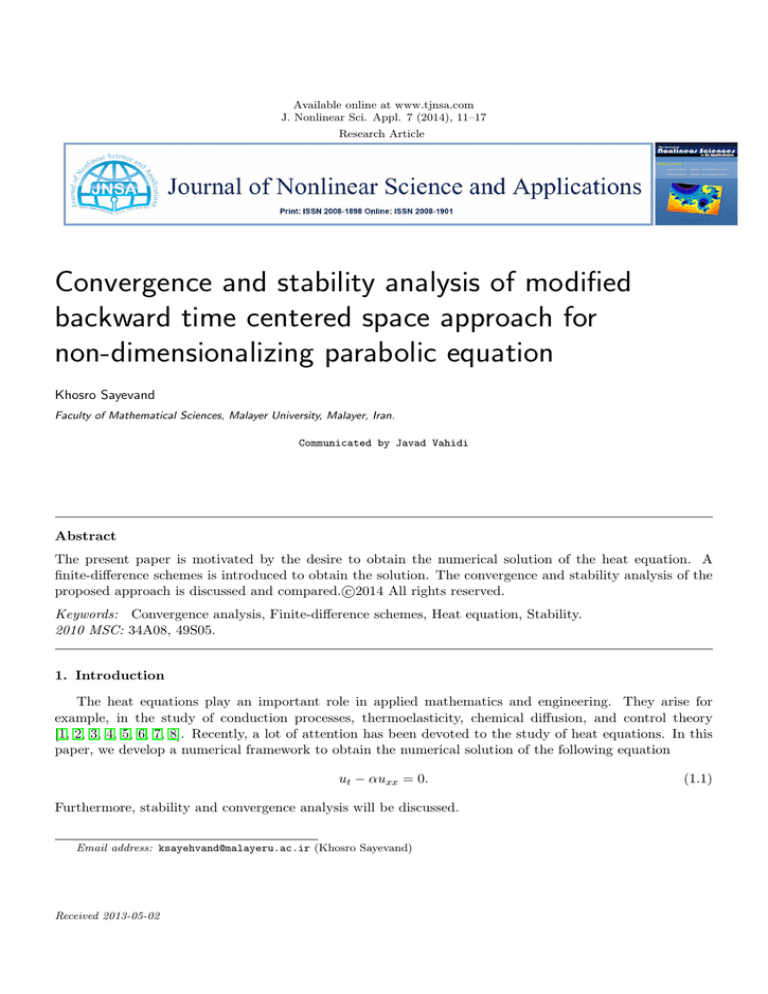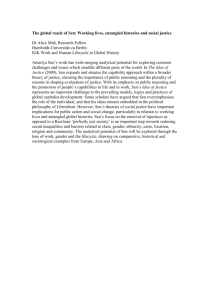
Available online at www.tjnsa.com
J. Nonlinear Sci. Appl. 7 (2014), 11–17
Research Article
Convergence and stability analysis of modified
backward time centered space approach for
non-dimensionalizing parabolic equation
Khosro Sayevand
Faculty of Mathematical Sciences, Malayer University, Malayer, Iran.
Communicated by Javad Vahidi
Abstract
The present paper is motivated by the desire to obtain the numerical solution of the heat equation. A
finite-difference schemes is introduced to obtain the solution. The convergence and stability analysis of the
c
proposed approach is discussed and compared.2014
All rights reserved.
Keywords: Convergence analysis, Finite-difference schemes, Heat equation, Stability.
2010 MSC: 34A08, 49S05.
1. Introduction
The heat equations play an important role in applied mathematics and engineering. They arise for
example, in the study of conduction processes, thermoelasticity, chemical diffusion, and control theory
[1, 2, 3, 4, 5, 6, 7, 8]. Recently, a lot of attention has been devoted to the study of heat equations. In this
paper, we develop a numerical framework to obtain the numerical solution of the following equation
ut − αuxx = 0.
Furthermore, stability and convergence analysis will be discussed.
Email address: ksayehvand@malayeru.ac.ir (Khosro Sayevand)
Received 2013-05-02
(1.1)
K. Sayevand, J. Nonlinear Sci. Appl. 7 (2014), 11–17
12
2. Background material and preliminaries
As we know, the heat equation is derived from Fourier’s law and conservation of energy. By Fourier’s
law, the flow rate of heat energy through a surface is proportional to the negative temperature gradient
across the surface,
q = −k∆u,
(2.1)
where k is the thermal conductivity and u is the temperature. In one dimension, we have
q = −kux ,
(2.2)
A change in internal energy per unit volume in the material, ∆Q is proportional to the change in temperature,
∆u. In the other words
∆Q = cp ρ∆u,
(2.3)
where cp is the specific heat capacity and ρ is the mass density of the material. Choosing zero energy at
absolute zero temperature, this can be rewritten as
Q = cp ρu,
(2.4)
The increase in internal energy in a small spatial region of the material, over the time period is given by
Z x+∆x
u(ξ, t + ∆t) − u(ξ, t − ∆t)dξ
(2.5)
Q = cp ρ
x−∆x
t+∆t Z x+∆x
Z
= cp ρ
t−∆t
x−∆x
∂u
dξdτ .
∂x
(2.6)
Consequently, by Fourier’s law in [x − ∆x, x + ∆x] we obtain
Z t+∆t
Z t+∆t Z x+∆x 2
∂u
∂u
∂ u
k
(x + ∆x, τ ) −
(x − ∆x, τ )dτ = k
dξdτ .
2
∂x
t−∆t ∂x
t−∆t
x−∆x ∂x
(2.7)
Again by the fundamental theorem of calculus and by conservation of energy, we obtain
Z
t+∆t Z x+∆x t−∆t
cp ρ
x−∆x
∂2u ∂u
− k 2 dξdτ = 0.
∂t
∂x
(2.8)
By the fundamental lemma of the calculus of variations, the integrand must vanish identically
cp ρ
∂u
∂2u
− k 2 = 0.
∂t
∂x
Which can be written as
ut =
(2.9)
k
uxx ,
cp ρ
(2.10)
k
,
cp ρ
(2.11)
if
α=
consequently, one will set
ut = αuxx .
(2.12)
K. Sayevand, J. Nonlinear Sci. Appl. 7 (2014), 11–17
13
3. Analysis of the proposed approach
In this section we introduce our numerical method for solving the heat equation. Consider heat equation
as
ut = αuxx , 0 < t < T, 0 < x < L,
(3.1)
with the initial and boundary conditions in the following form
u(x, 0) = ξ(x), u(0, t) = 0, u(L, t) = η(t).
(3.2)
Let u(x, t) represent the exact solution of a partial differential equation with independent variables x and
L
T
t. Define tn = n∆t, n = 0, 1, 2, · · · , N, xi = i∆x, i = 0, 1, 2, · · · , M, where ∆x = M
and ∆t = N
are space
n
and time steps, respectively. We suppose that ui as the numerical solution in the difference method and
4t u(xi , tk ) = u(xi , tk+1 ) − u(xi , tk ).
(3.3)
Using the forward time formula at xi and the centered space formula at tn+1 , difference approximation of
the Eq. (3.1) is
n+1
un+1
+ un+1
un+1
− uni
i−1 − 2ui
i+1
i
=α
,
(3.4)
∆t
(∆x)2
or
n+1
n
− sun+1
− sun+1
(3.5)
i−1 + (1 + 2s)ui
i+1 = ui ,
where s =
α(∆t)
(∆x)2
> 0.
In partial differential equation (PDE), the local truncation error is defined as the difference of the finite
difference scheme and partial differential equation. The finite difference scheme is consistent if the limit of
the local truncation error is zero as ∆x and/or ∆t approach zero.
Using the Taylor expanding around (xi , tk+1 ) for Eq. (3.5) and summarizing the formula, the following
relation can be obtained
∂u
1 ∂2u
∂2u 2
2 ∂3u 3
∂3u
n
2
2
− s 2ui + 2 ∆t +
∆x + 2 ∆t +
∆t + 3 2 ∆x ∆t
∂t
2! ∂x2
∂t
3! ∂t3
∂x ∂t
4u
4u
2 ∂4u
∂
∂
+
∆x4 + 4 ∆t4 + 6 2 2 ∆x2 ∆t2
4! ∂x4
∂t
∂x ∂t
2u
∂u
1
∂
2
+ (1 + 2s) uni +
∆t +
∆t
+
·
·
·
− uni = 0,
(3.6)
∂t
2i ∂t2
because of
∂u
∂u
∂2u
∂2u
(1 + 2s)∆t − 2s∆t =
(∆t) 2 (−s(∆x)2 ) = −s∆x2 2 ,
∂t
∂t
∂x
∂x
(3.7)
and
∂4u
s
(1 + 2s) 2 2
2
2
2
4
−α ∆t − sα∆t∆x − ∆x +
α ∆t
∂x4
12
2
∂4u
s ∆x2 1 ∆t 2
=
α∆t∆x
−
s
−
+ α
∂x4
12 α∆t 2 ∆x2
∂4u 1
1
= α∆t∆x2 4 − s −
∂x
2
12
4u
α
∂
= − ∆t∆x2 4 (6s + 1).
12
∂x
At last, we obtain this formula
∂4u
∂u
∂2u
α
− α 2 − ∆x2 4 (1 + 6s) + O{(∆x)4 } = 0.
∂t
∂x
12
∂x
(3.8)
K. Sayevand, J. Nonlinear Sci. Appl. 7 (2014), 11–17
14
that shows the order of accuracy is O((∆x)2 ). Now if (∆t, ∆x) → 0, the above statement tends to Eq. (3.1)
and therefore this method of finite difference is consistent with the partial differential equation.
Hereunder, we present two theorems that are used in next sections.
Theorem 1. Suppose that B = T rid(a, b, c) be an arbitrary matrix. Consequently, the eigenvalues of B
are
√
kπ
λ = b + 2 ac cos
, k = 0, 1, · · · , M − 1.
(3.9)
M
Proof. Suppose that λ is an eigenvalue of B and x = [x1 , x2 , · · · , xk ] is the corresponding eigenvector of λ.
We have
(A − λI)x = 0,
(3.10)
or if define the initial condition as x0 = xn = 0, then we can write the following difference equation
axj−1 + (b − λ)xj + cxj+1 = 0, j = 1, · · · , n
(3.11)
Solutions of the equation are as xk = rk that by substituting in Eq. (3.11), we have
cr2 + (b − λ)r + a = 0,
(3.12)
Let r1 and r2 are roots of (3.12). Then the general answer of (3.11) is as xk = c1 r1k + c2 r2k . According to
initial conditions,
x0 = 0 =⇒ α1 = −α2 ,
r n+1
1
xn+1 = 0 =⇒
= 1 = e−i2kπ , k = 1, · · · N.
r2
Therefore
r
r1 =
a i Nkπ
e +1 , r2 =
c
(3.13)
r
a −i Nkπ
+1 .
e
c
(3.14)
In the other words
r kπ √
kπ
a i Nkπ
λ=b+c
e +1 + e−i N +1 = b + 2 ac cos
, k = 1, · · · , N,
c
N +1
(3.15)
and finally the last relation can be obtained as
kπ √
λ = b + 2 ac cos
, k = 0, 1, · · · , M − 1.
M
(3.16)
Theorem 2. If B be a square matrix, then these relations are equivalent [5]
(1) limk→∞ B k = 0,
(2)(∀v) limk→∞ B k v = 0,
(3)ρ(B) < 1,
(4)∃k.k s.t ||B|| < 1, where ρ = (max λi ) and (λi )s are the eigenvalues of B.
4. Stability
Theorem 3. A finite one-step difference scheme Ph,τ uki = 0 for a first order PDE is stable if there exist
numbers τ0 > 0 and h0 > 0 such that for any T > 0 there exists a constant CT such that
kuk k ≤ ku0 kCT ,
(4.1)
for 0 < kτ < T, 0 < h < h0 , 0 < τ < τ0 . Therefore, the scheme is stable if the truncation error doesn’t
growth. That is
K. Sayevand, J. Nonlinear Sci. Appl. 7 (2014), 11–17
15
If E n = [en1 , en2 , · · · , enM −1 ]T , then kE n+1 k∞ ≤ kE n k∞ , n = 0, 1, 2, · · · .
Proof. The difference approximation form of the Eq. (3.5) is
n+1
n
− sen+1
− sen+1
i−1 + (1 + 2s)ei
i+1 = ei , i = 1, 2, · · · , M − 1.
(4.2)
Substituting values of i, as follows
i = 1 : −sen+1
+ (1 + 2s)en+1
− sen+1
= en1 ,
0
1
2
n+1
n+1
n+1
n
i = 2 : −se1 + (1 + 2s)e2 − se3 = e2 ,
(4.3)
..
.
i = m − 1 : −sen+1 + (1 + 2s)en+1 − sen+1 = en ,
m
m−1
m−2
m−1
Consequently, we can obtain
|
(1 + 2s)
−s
0 ...
0
−s
(1 + 2s) −s . . .
0
..
..
..
..
..
.
.
.
.
.
0
0
0 −s (1 + 2s)
{z
A
n+1
e1
..
.
.
..
n+1
} | em−1
{z
=
}
E n+1
|
en1
..
.
..
.
enm−1
{z
En
.
}
where A = T rid(−s, 1 + 2s, −s).
According to Theorem (3) we have
λ(A) = (1 + 2s) + 2s cos(
kπ
kπ
) = 1 + 4s cos2 ( ) > 1,
M
M
(4.4)
and λ(A−1 ) < 1. On the other hand
E n+1 = A−1 E n .
(4.5)
Corresponding the Theorem (3) and Eq. (4.5) the following relation can be obtained
kE n+1 k≤kE n k.
(4.6)
Thus, the truncation error doesn’t growth and the scheme is unconditionally stable.
5. Convergence
Theorem 4. A finite difference scheme approximating of a PDE is convergent if uki , tends to u(x, t), at a
fixed point or along a t-level as ∆x and ∆t both tend to zero.
Proof. We assume that u
eji is the approximate solution of (3.1,3.2) and
eji = u
eji − uji ,
(5.1)
is the error of method for i = 0, 1, · · · , M, j = 0, 1, · · · , N .
Substituting (5.1) in difference Eq. (3.5), we have
!
n+1
n+1
n+1
eni = −sen+1
− sen+1
+ ûn+1
i−1 + (1 + 2s)ei
i+1 + s ûi+1 − 2ûi
i−1
!
−
ûn+1
− ûni .
i
K. Sayevand, J. Nonlinear Sci. Appl. 7 (2014), 11–17
16
Then by using the Taylor expanding around (xi , tn ) and Mean Value Theorem, the previous relation can be
rewritten as follows
n+1
eni = −sen+1
− sn+1
i−1 + (1 + 2s)ei
i+1
n
2 n+1
n+1
1
∂u
n+1
n+1
2 ∂ u
+ ∆x
+
·
·
·
−
û
+ s ûi
+ ∆x
i
∂x i
2!
∂x2 i
i+θ2
∂u
n
− ûni + ∆t + · · · − ûni .
∂x i
or
eni
=
−sen+1
i−1
+ (1 +
2s)en+1
i
−
sen+1
i+1
∂ 2 u n+1
∂2u
∂u n+θ1
n+1
2
+s
+
(∆x) .
− (∆t)
∂t i
∂x2 i+θ2 ∂x2 i−θ3
(5.2)
Let |enmax | = max1≤i≤M −1 |eni | and M̄ = max Rin , 1 ≤ i ≤ M − 1, 1 ≤ n ≤ N . where
Rin =
∂u n+θ1 ∂ 2 u n+1
∂2u
n+1
+
+s
(∆x)2 .
∂t i
∂x2 i+θ2 ∂x2 i−θ3
It is sufficient to show |eN
max | → 0 while (∆x, ∆t) → 0. According to Eq. (5.2)
n+1 n+1
− sen+1
|eni | ≤ − sen+1
i−1 + (1 + 2s)ei
i+1 − (∆t)M̄ ≤ emax − ∆tM̄ , n = 0, 1, · · · , N − 1.
Substituting values of n, as follows
0 1
emax + ∆tM̄ ,
|
≤
n
=
0
:
|e
max
1
2
emax + (∆t)M̄ ,
|
≤
n
=
1
:
|e
max
(5.3)
(5.4)
(5.5)
..
.
n = N − 1 : |en | ≤ n(∆t)M̄ .
max
Also, if (∆t, ∆x) → 0, then θ1 , θ2 , θ3 → 0. Thus
lim
M̄ =
(∆t,∆x)→0
lim
(∆t,∆x)→0
lim
(∆t,∆x)→0
max
max Rin =
∂ 2 u n+1
∂u n+θ1 ∂2u
n+1
+s
+
(∆x)2 = 0.
∂t i
∂x2 i+θ2 ∂x2 i−θ3
Because of |emax | ≤ n(∆t)M̄ , thus |emax | → 0. This shows that the method is convergence to the Eq. (3.1).
6. Numerical examples
Consider the following problems
Case 1.
5
uxx , 0 ≤ x ≤ 20, 0 ≤ t ≤ 604.8,
42
with the boundary and initial conditions
ut =
u(0, t) = 0, u(20, t) = 10, u(x, 0) = 2.
(6.1)
(6.2)
K. Sayevand, J. Nonlinear Sci. Appl. 7 (2014), 11–17
17
For ∆t = 67.2 and ∆x = 4, the solution obtained by our proposed approach is recorded in Table 1.
Case 2.
1
ut = uxx , 0 ≤ x ≤ 1, 0 ≤ t ≤ 1,
4
with the boundary and initial conditions
(6.3)
u(0, t) = 0, u(1, t) = 0, u(x, 0) = sin(πx).
(6.4)
For ∆t = 0.1 and ∆x = 0.1, the solution obtained by our proposed approach is recorded in Table 1.
T able 1
n(case1)
x
Error
n(case2)
x
Error
10
4
8
12
16
0.36455
0.60316
0.62005
0.39197
1
0.2
0.4
0.6
0.8
0.011801
0.024666
0.024666
0.011801
50
4
8
12
16
0.00035
0.00056
0.00056
0.00035
10
0.2
0.4
0.6
0.8
0.00012
0.00035
0.00035
0.00012
80
4
8
12
16
0
0
0
0
20
0.2
0.4
0.6
0.8
0
0
0
0
7. Conclusion
This paper has outlined an approach for the study of a heat differential equations. We studied the
numerical solution of this prototype phenomena. The explicit finite-difference schemes, were applied to the
mentioned model and the proposed numerical scheme solved this model quite satisfactory. The results reveal
that our proposed strategy is effective and excellent.
References
[1] W. A. Day, Extension of a property of the heat equation to linear thermoelasticity and other theories, Quart. Appl. Math.
40 (1982), 319–330. 1
[2] A. R. Mitchell, D. F. Griffiths, The finite difference methods in partial differential equations, Wiley, New York, (1980). 1
[3] R. F. Waxming, B. J. Hyett, The modified equation approach to the stability and accuracy analysis of finite-difference
methods, J. Comput. Phys. 14 (1974), 159-179. 1
[4] L. Lapidus, G.F. Pinder, Numerical solution of partial differential equations in science and engineering, Wiley, New York,
(1982). 1
[5] C.F. Gerald, P.O. Wheatley, Applied numerical analysis, Fifth Edition, Addison-Wesley, (1994). 1, 3
[6] J. R. Cannon, S. Prez-Esteva , J. Van Der Hoek, A Galerkin procedure for the diffusion equation subject to the specification
of mass, SIAM J. Num. Anal. 24 (1987), 499–515. 1
[7] G.R. Habetlet, R.I. Schiffman, A finite difference method for analysing the compression of pro-viscoelasticmedia, Computing
6 (1970), 342–348. 1
[8] R.K. Miller, An integro-differential equation for rigid heat conduction equations with memory, J. Math. Anal. Appl. 66
(1978), 318–327. 1







